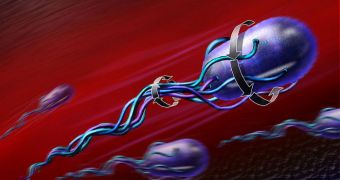At the micro- and nano-scales, a large number of events take place at any given time. Inside living cells the amount of reactions that take place, for example, is exceedingly large and complex, and science has been trying to keep up through new discoveries for many years. However, experts knew that they were limited in their quest for knowledge by the fact that they could only see what was going on at these levels of miniaturization, and not hear these events. Now, a group finally managed to get past this limitation, by creating “micro-ears” that allow scientists to listen to the noises that, for example, the flagellum of a bacteria makes when the microorganism is moving, the BBC News reports.
This is likely to be one of the new technology's primary applications. Molecular biologists say that they plan to combine the new observations method with microscope imaging, so as to obtain the most complete picture possible of cells, human or otherwise, as they engage in repeating activities. Many cellular organisms exhibit patterns in their actions, and researchers want to get the most complete and thorough view possible of why these behaviors occur. The underlying mechanisms are also of great interest, as they can illustrate why some disorders occur, and also a number of methods to prevent them, that could result in groundbreaking new therapies.
Scientists could also become able in the near-future to listen to the action of drugs on bacteria and microbes, and determine the effectiveness that a therapy using those chemicals would have in real life. Researchers from three research institutions in the United Kingdom are currently working on a prototype device, in a bid to assess its functionality and possible uses. The teams are based at the Universities of Glasgow and Oxford, and also at the National Institute of Medical Research at Mill Hill. The new system is based on the already-established technology of optical tweezers.
“We are now using the sensitivity afforded by the optical tweezer as a very sensitive microphone. The optical tweezer can measure or manipulate at piconewton forces,” explains team leader and University of Glasgow professor, Jon Cooper. The device uses lasers to determine the frequency at which microorganisms such as E. coli vibrate, and then routes the signal to external speakers, which relay it to scientists. This particular bacterium is a prime candidate for testing the device, researchers say. “Because this tech is so new and these guys are exploring what's possible the flagellar motor will be a very good test for the technology,” says University of Oxford physicist Dr Richard Berry.

 14 DAY TRIAL //
14 DAY TRIAL //